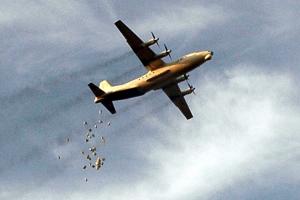Amid multiple crises, UN agency massively scales up humanitarian aid delivery by air
The escalation of international conflicts in the first half of 2014 prompted a 50-fold surge in the amount of humanitarian cargo transported by the United Nations World Food Programme (WFP), compared to the same period last year.

Transportation of humanitarian aid by air remains one of the most effective ways to reach populations in need, particularly in areas with limited access due to high security risks, poor infrastructure, and rainy season.
WFP Aviation delivered by air 7,600 tons of food and 1,189 tons of life-saving supplies to 21 countries in the past six months. Over 90 per cent of relief supplies was transported to emergency areas such as Central African Republic (22 per cent), South Sudan (53 per cent) and Syria (16 per cent).
“Dealing with simultaneous emergencies in three countries – the Central African Republic, South Sudan and Syria – meant calling on our deep expertise in tough places and WFP’s ability to scale up swiftly to deliver life-saving supplies to people in desperate need,” Cesar Arroyo, Chief, WFP Aviation Service, said at a briefing in Geneva as he presented the agency’s 2013 Aviation Report.
In addition to the total figure of the 8,789 tons of humanitarian goods, WFP Aviation carried out 236 airdrops of food supplies to inaccessible areas of South Sudan for 300,000 people displaced by the recent violence. In comparison with airlifts that allow transportation of fragile cargo in areas where aircrafts can easily land, airdrops are more effective in the remote communities without landing facilities.
Transportation of humanitarian aid by air remains one of the most effective ways to reach populations in need, particularly in areas with limited access due to high security risks, poor infrastructure, and rainy season.
Among the problems that WFP faces are a shortage of sufficient air assets, administrative bottlenecks, and cost variations on the charter market during emergencies. The agency needs timely and flexible funding to ensure a more effective response to the humanitarian needs of the affected populations and simultaneously tackle multiple emergencies.
WFP is the world's largest humanitarian agency fighting hunger worldwide. In 2013, together with the UN Humanitarian Air Service (UNHAS), the agency assisted more than 80 million people in 75 countries.
Source: UN News
- 460 reads
Human Rights
Ringing FOWPAL’s Peace Bell for the World:Nobel Peace Prize Laureates’ Visions and Actions

Protecting the World’s Cultural Diversity for a Sustainable Future

The Peace Bell Resonates at the 27th Eurasian Economic Summit

Declaration of World Day of the Power of Hope Endorsed by People in 158 Nations

Puppet Show I International Friendship Day 2020

